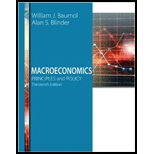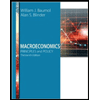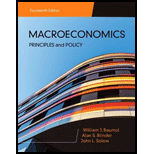
Macroeconomics: Principles and Policy (MindTap Course List)
13th Edition
ISBN: 9781305280601
Author: William J. Baumol, Alan S. Blinder
Publisher: Cengage Learning
expand_more
expand_more
format_list_bulleted
Question
Chapter 7, Problem 1TY
To determine
To analyze:The percentage growth in labor productivity.
Expert Solution & Answer
Explanation of Solution
Percentage change in labor productivity can be calculated by dividing the change in productivity by the old output.
For country A, it is
Similarly, it can be calculated for other countries:
| Output per Hour | Percentage Change In productivity | ||
| 2004 | 2014 | ||
| Country A | 40 | 48 | 20 |
| Country B | 25 | 35 | 40 |
| Country C | 2 | 3 | 50 |
| Country D | 0.5 | 0.6 | 20 |
Country D had lowest productivity in year 2004, which was 0.5 units/hr. But the percentage growth of labor productivity is highest in country C, which is 50%. Hence, it is not true that productivity growth was highest where the initial level of productivity was the lowest.
Want to see more full solutions like this?
Subscribe now to access step-by-step solutions to millions of textbook problems written by subject matter experts!
Students have asked these similar questions
1. After the reopening of borders with mainland China following the COVID-19 lockdown, residents
living near the border now have the option to shop for food on either side. In Hong Kong, the cost
of food is at its listed price, while across the border in mainland China, the price is only half that
of Hong Kong's. A recent report indicates a decline in food sales in Hong Kong post-reopening.
**
Diagrams need not be to scale; Focus on accurately representing the relevant concepts
and relationships rather than the exact proportions.
(a) Using a diagram, explain why Hong Kong's food sales might have dropped after the border
reopening. Assume that consumers are indifferent between purchasing food in Hong Kong or
mainland China, and therefore, their indifference curves have a slope of one like below.
Additionally, consider that there are no transport costs and the daily food budget for consumers
is identical whether they shop in Hong Kong or mainland China. I
3.
14
(b) In response to the…
2. Health Food Company is a well-known global brand that specializes in healthy and organic food
products. One of their main products is organic chicken, which they source from small farmers
in the area. Health Food Company is the sole buyer of organic chicken in the market.
(a) In the context of the organic chicken industry, what type of market structure is Health Food
Company operating in?
(b) Using a diagram, explain how the identified market structure affects the input pricing and
output decisions of Health Food Company. Specifically, include the relevant curves and
any key points such as the profit-maximizing price and quantity. ()
(c) How can encouraging small chicken farmers to form bargaining associations help improve
their trade terms? Explain how this works by drawing on the graph in answer (b) to
illustrate your answer.
2. Suppose that a farmer has two ways to produce his crop. He can use a low-polluting
technology with the marginal cost curve MCL or a high polluting technology with the
marginal cost curve MCH. If the farmer uses the high-polluting technology, for each unit of
quantity produced, one unit of pollution is also produced. Pollution causes pollution
damages that are valued at $E per unit. The good produced can be sold in the market for $P
per unit.
P
1
MCH
0
Q₁
MCL
Q2
E
a.
b.
C.
If there are no restrictions on the firm's choices, which technology will the farmer use and
what quantity will he produce? Explain, referring to the area identified in the figure
Given your response in part a, is it socially efficient for there to be no restriction on
production? Explain, referring to the area identified in the figure
If the government restricts production to Q1, what technology would the farmer choose?
Would a socially efficient outcome be achieved? Explain, referring to the area identified in…
Chapter 7 Solutions
Macroeconomics: Principles and Policy (MindTap Course List)
Knowledge Booster
Similar questions
- I need help in seeing how these are the answers. If you could please write down your steps so I can see how it's done please.arrow_forwardSuppose that a random sample of 216 twenty-year-old men is selected from a population and that their heights and weights are recorded. A regression of weight on height yields Weight = (-107.3628) + 4.2552 x Height, R2 = 0.875, SER = 11.0160 (2.3220) (0.3348) where Weight is measured in pounds and Height is measured in inches. A man has a late growth spurt and grows 1.6200 inches over the course of a year. Construct a confidence interval of 90% for the person's weight gain. The 90% confidence interval for the person's weight gain is ( ☐ ☐) (in pounds). (Round your responses to two decimal places.)arrow_forwardSuppose that (Y, X) satisfy the assumptions specified here. A random sample of n = 498 is drawn and yields Ŷ= 6.47 + 5.66X, R2 = 0.83, SER = 5.3 (3.7) (3.4) Where the numbers in parentheses are the standard errors of the estimated coefficients B₁ = 6.47 and B₁ = 5.66 respectively. Suppose you wanted to test that B₁ is zero at the 5% level. That is, Ho: B₁ = 0 vs. H₁: B₁ #0 Report the t-statistic and p-value for this test. Definition The t-statistic is (Round your response to two decimal places) ☑ The Least Squares Assumptions Y=Bo+B₁X+u, i = 1,..., n, where 1. The error term u; has conditional mean zero given X;: E (u;|X;) = 0; 2. (Y;, X¡), i = 1,..., n, are independent and identically distributed (i.i.d.) draws from i their joint distribution; and 3. Large outliers are unlikely: X; and Y, have nonzero finite fourth moments.arrow_forward
- Asap pleasearrow_forwardTasks Exercise 1 Assess the following functions: 1. f(x)= x2+6x+2 2.f '(x)=10x-2x2+5 a. Find the stationary points. (5 marks) b. Determine whether the stationary point is a maximum or minimum. (5 marks) c. Draw the corresponding curves (5 marks)arrow_forwardProblem 2: The sales data over the last 10 years for the Acme Hardware Store are as follows: 2003 $230,000 2008 $526,000 2004 276,000 2009 605,000 2005 328,000 2010 690,000 2006 388,000 2011 779,000 2007 453,000 2012 873,000 1. Calculate the compound growth rate for the period of 2003 to 2012. 2. Based on your answer to part a, forecast sales for both 2013 and 2014. 3. Now calculate the compound growth rate for the period of 2007 to 2012. 1. Based on your answer to part e, forecast sales for both 2013 and 2014. 5. What is the major reason for the differences in your answers to parts b and d? If you were to make your own projections, what would you forecast? (Drawing a graph is very helpful.)arrow_forward
- Exercise 4A firm has the following average cost: AC = 200 + 2Q – 36 Q Find the stationary point and determine if it is a maximum or a minimum.b. Find the marginal cost function.arrow_forwardExercise 4A firm has the following average cost: AC = 200 + 2Q – 36 Q Find the stationary point and determine if it is a maximum or a minimum.b. Find the marginal cost function.arrow_forwardExercise 2A firm has the following short-run production function: Q = 30L2 -0.5L3a. Make a table with two columns: Production and Labour b. Add a third column to the table with the marginal product of labour c. Graph the values that you estimated for the production function and the marginal product oflabour Exercise 3A Firm has the following production function: Q= 20L-0.4L2a. Using differential calculus find the unit of labour that maximizes the production. b. Estimate function of Marginal product of labor c. Obtain the Average product of labor. d. Find the point at which the Marginal Product of Labour is equal to the Average Product of Labour.arrow_forward
- Problem 3 You have the following data for the last 12 months' sales for the PRQ Corporation (in thousands of dollars): January 500 July 610 February 520 August 620 March 520 September 580 April 510 October 550 May 530 November 510 June 580 December 480 1. Calculate a 3-month centered moving average. 2. Use this moving average to forecast sales for January of next year. 3. If you were asked to forecast January and February sales for next year, would you be confident of your forecast using the preceding moving averages? Why or why not? expect? Explain.arrow_forwardProblem 5 The MNO Corporation is preparing for its stockholder meeting on May 15, 2013. It sent out proxies to its stockholders on March 15 and asked stockholders who plan to attend the meeting to respond. To plan for a sufficient number of information packages to be distributed at the meeting, as well as for refreshments to be served, the company has asked you to forecast the number of attending stockholders. By April 15, 378 stockholders have expressed their intention to attend. You have available the following data for the last 6 years for total attendance at the stockholder meeting and the number of positive responses as of April 15: Year Positive Responses Attendance 2007 322 520 2008 301 550 2009 398 570 2010 421 600 2011 357 570 2012 452 650 1. What is your attendance forecast for the 2013 stockholder meeting? 2. Are there any other factors that could affect attendance, and thus make your forecast inac- curate?arrow_forwardProblem 4 Office Enterprises (OE) produces a line of metal office file cabinets. The company's economist, having investigated a large number of past data, has established the following equation of demand for these cabinets: Q=10,000+6013-100P+50C Q=Annual number of cabinets sold B = Index of nonresidential construction P = Average price per cabinet charged by OE C=Average price per cabinet charged by OE's closest competitor It is expected that next year's nonresidential construction index will stand at 160, OE's average price will be $40, and the competitor's average price will be $35. 1. Forecast next year's sales. 2. What will be the effect if the competitor lowers its price to 832? If it raises its price to $36? 3. What will happen if OE reacts to the decrease mentioned in part b by lowering its price to $37? 4. If the index forecast was wrong, and it turns out to be only 140 next year, what will be the effect on OE's sales? If not, what does it measure?arrow_forward
arrow_back_ios
SEE MORE QUESTIONS
arrow_forward_ios
Recommended textbooks for you
 Macroeconomics: Principles and Policy (MindTap Co...EconomicsISBN:9781305280601Author:William J. Baumol, Alan S. BlinderPublisher:Cengage Learning
Macroeconomics: Principles and Policy (MindTap Co...EconomicsISBN:9781305280601Author:William J. Baumol, Alan S. BlinderPublisher:Cengage Learning

 Exploring EconomicsEconomicsISBN:9781544336329Author:Robert L. SextonPublisher:SAGE Publications, Inc
Exploring EconomicsEconomicsISBN:9781544336329Author:Robert L. SextonPublisher:SAGE Publications, Inc Economics (MindTap Course List)EconomicsISBN:9781337617383Author:Roger A. ArnoldPublisher:Cengage Learning
Economics (MindTap Course List)EconomicsISBN:9781337617383Author:Roger A. ArnoldPublisher:Cengage Learning

Macroeconomics: Principles and Policy (MindTap Co...
Economics
ISBN:9781305280601
Author:William J. Baumol, Alan S. Blinder
Publisher:Cengage Learning



Exploring Economics
Economics
ISBN:9781544336329
Author:Robert L. Sexton
Publisher:SAGE Publications, Inc

Economics (MindTap Course List)
Economics
ISBN:9781337617383
Author:Roger A. Arnold
Publisher:Cengage Learning
